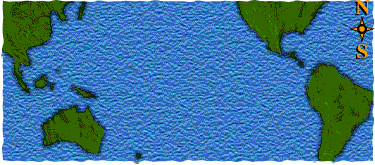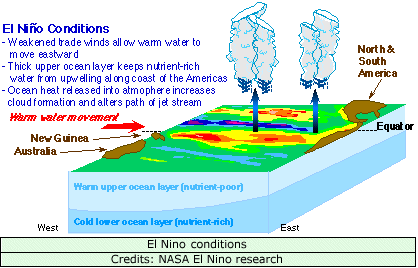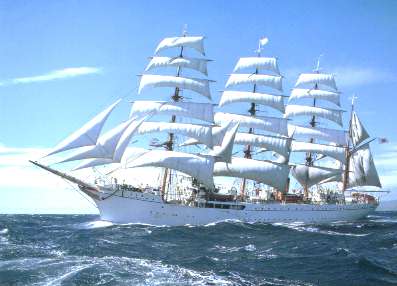Why does it happen?
|
|
The oceans and the winds that blow across our planet are like a big weather engine. We have parts of the ocean that are warm, and parts that are colder. There are also winds that nearly always blow in the same direction (we call these trade winds). These are the winds early sailors used to travel across the great oceans. |
If you ask "Why are there trade
winds?", I will say "That's simple, there are trade winds
because the water is cold in the east and warm in the west".
But if you ask "Why is the water
cold in the east and warm in the west?", I'll say "That's
simple too, it's because there are trade winds". The ocean and the atmosphere are
bound together in a system where each one affects the
other. When the trade winds (shown in
cream) in the animation blow less, the waters warm up more
to the east (shown in red). But no-one can say which causes
the other. It is a chicken and the egg scenario! Usually, the wind blows strongly
from east to west along the equator in the Pacific. This
actually piles up water (about half a meter) in the western
part of the Pacific. In the eastern part, deeper water
(which is colder than the sun-warmed surface
water) gets pulled up from below to replace the water
pushed west. So, the normal situation is warm water (about
30 C) in the west, cold (about 22 C) in the east. In an El Niño, the winds
pushing that water around get weaker. As a result, some of
the warm water piled up in the west slumps back down to the
east, and not as much cold water gets pulled up from below.
Both these tend to make the water in the eastern Pacific
warmer, which is one of the hallmarks of an El
Niño. But it doesn't stop here. The warmer
ocean then affects the winds--it makes the winds weaker! So
if the winds get weaker, then the ocean gets warmer, which
makes the winds get weaker, which makes the ocean get warmer
... this is called a positive feedback, and is what makes an
El Niño grow.

Back to
Top

